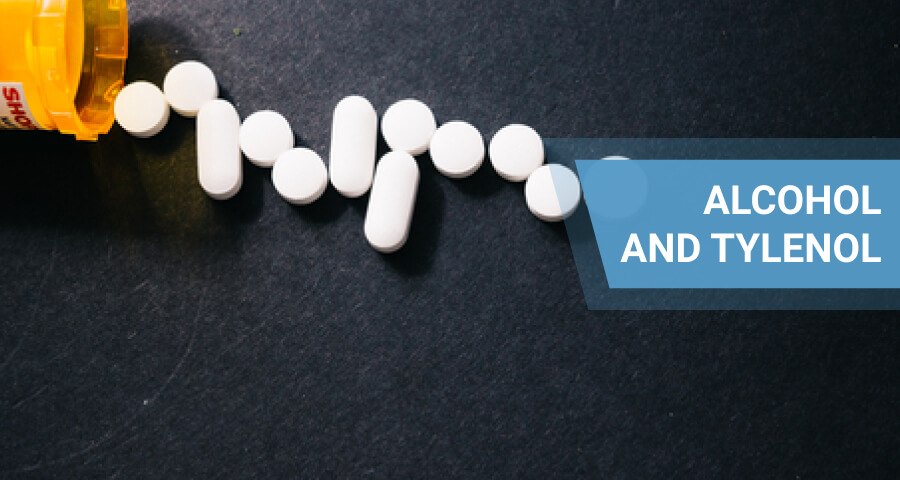
Tylenol (acetaminophen) toxicity stands as a significant public health concern, ranking as the second leading cause of liver transplantation globally and the first in the U.S.
Despite its associated health risks, over 60 million Americans take acetaminophen weekly, often without realizing the potential dangerous interactions with other substances such as alcohol. Combining acetaminophen and alcohol can increase the risk of liver damage and acute liver failure.
Continue reading to learn about the risks of mixing alcohol and Tylenol, potential signs of liver damage, and best practices for acetaminophen treatment.
Table Of Contents:
- What is Tylenol?
- Can You Take Tylenol After Drinking? Tylenol and Alcohol Interactions
- How Long Can I Take Tylenol After Drinking?
- Signs of Tylenol and Alcohol Interaction
- Tylenol Alternatives
- Tylenol Alcohol: Tips for Reducing Liver Damage
- Can You Drink With Tylenol? − Key Takeaways
- People Also Ask

What is Tylenol?
Trade Name: Tylenol®
Generic Name: Acetaminophen
Tylenol is a brand name for the over-the-counter medication known generically as acetaminophen. It’s commonly used to relieve pain and reduce fever.
Acetaminophen is a non-opioid analgesic found in various forms, including tablets, capsules, liquid suspensions, and even combination products with other medications like cold and flu remedies.
Tylenol is widely available and considered safe when used as directed. A significant number of Tylenol overdoses occur due to intentional self-harm, yet a considerable amount happens accidentally. The recommended maximum daily dose of acetaminophen for adults is 4g/day.
Can You Take Tylenol After Drinking? Tylenol and Alcohol Interactions
The labels on all over-the-counter pain relievers and fever reducers advise individuals who consume three or more alcoholic drinks daily to seek advice from a doctor before using these medications.
Here are the reasons why you shouldn’t mix Tylenol with alcohol:
Liver Toxicity Risk
Combining acetaminophen with alcohol increases the risk of liver damage.
Both substances are metabolized in the liver, and the simultaneous presence of alcohol can interfere with the liver’s ability to process acetaminophen effectively. This interference can lead to the accumulation of toxic byproducts from acetaminophen metabolism, potentially causing liver toxicity and even liver failure.
Delayed Tylenol Metabolism
The liver uses specific enzymes to break down Tylenol and alcohol. When you consume both substances, they compete for these enzymes.
However, the liver prioritizes metabolizing alcohol over other substances, leaving less enzyme activity available for Tylenol breakdown, causing a backlog prolonging its presence in the body and increasing the risk of toxicity. This is particularly dangerous since you might feel less pain relief initially, potentially leading you to take another dose of Tylenol and exceeding the recommended daily limit.
Increased Risk of Liver Damage
Acetaminophen alone is known to cause liver damage when taken in excessive doses. Combining acetaminophen with alcohol exacerbates this risk due to the synergistic effect on liver function. Even moderate alcohol consumption can heighten the susceptibility to acetaminophen-induced liver injury.
Delayed Symptom Recognition
Mixing alcohol and acetaminophen can mask symptoms of liver damage, making it difficult to recognize the gravity of the situation. Symptoms of liver damage, such as abdominal pain, jaundice and nausea, may be attributed to alcohol consumption rather than acetaminophen toxicity, delaying appropriate medical intervention.
The specific quantities and timing of consuming Tylenol and alcohol that may cause liver damage are not known and may respond to individual vulnerabilities.
How Long Can I Take Tylenol After Drinking?
if you are wondering about Tylenol and alcohol, how long to wait? You need to know that the timing for taking Tylenol after drinking alcohol depends on the amount of alcohol consumed, individual metabolism and liver health.
As a general guideline, it’s advisable to wait until the alcohol has been fully metabolized and cleared from your system before taking acetaminophen to minimize the risk of liver damage. The half-life of acetaminophen, which is the time it takes for half of the drug to be eliminated from the body, is approximately 2 to 3 hours in healthy adults.
Based on this, waiting at least 4 to 6 hours after consuming alcohol before taking acetaminophen is recommended to allow for adequate metabolism of both substances and reduce the risk of liver toxicity. In patients with hepatic dysfunction, Tylenol clearance can take up to 17 hours.
Signs of Tylenol and Alcohol Interaction
Complications, common risks and side effects caused by this interaction may include:
- Severe abdominal pain, particularly in the upper right quadrant
- Persistent nausea and vomiting, especially when accompanied by abdominal discomfort
- Yellowing of the skin and whites of the eyes (jaundice)
- Excessive tiredness or fatigue that persists despite rest
- Urine that appears darker than usual
- Stools that are pale or clay-colored
- Changes in mental status, confusion or difficulty concentrating
- Bleeding or bruising as impaired liver function (decreased production of clotting factors)
- A sudden loss of appetite or aversion to food
- Significant and unexplained weight loss
Tylenol Alternatives
If you need pain relief or have a fever, consider using alternative medications that do not contain acetaminophen, such as:
- Ibuprofen (Advil, Motrin)
- Naproxen (Aleve)
- Aspirin
- Acetaminophen-free cold and flu medications
- Topical analgesics (creams, gels or patches for localized pain relief)
Tylenol Alcohol: Tips for Reducing Liver Damage
Considering the serious potential health damage from the Tylenol PM and alcohol interaction, consider the following tips to protect your liver:
- Respect the recommended daily limits for acetaminophen and alcohol consumption.
- Carefully read the labels of over-the-counter medications to check for acetaminophen content.
- Avoid products containing acetaminophen if you have consumed alcohol or are planning to do so.
- Aim to wait at least 4 to 6 hours after drinking before taking acetaminophen.
- Drink plenty of water when consuming alcohol to stay hydrated and support liver function.
- Be vigilant for signs of liver damage, especially if you have taken acetaminophen after drinking alcohol.
- Seek medical attention if you experience any concerning symptoms.
Can You Drink With Tylenol? − Key Takeaways
While it’s technically possible to drink alcohol while taking Tylenol, it’s not advisable due to the heightened risk of liver damage.
Those at greater risk include individuals with preexisting liver conditions, heavy drinkers, and those who regularly consume large doses of acetaminophen. The good news is that Tylenol can be used for managing pain and fever in patients with alcohol use disorder, but dosage must be strictly followed.
To avoid acetaminophen overdose and alcohol dependency, carefully monitor medication labels, respect dosage, and limit alcohol intake to no more than two drinks a day. If addiction or overdose is suspected, seeking medical assistance promptly is crucial.
People Also Ask
Can I take Tylenol after drinking?
It’s best to avoid Tylenol after heavy drinking (more than 3-4 drinks). Both strain your liver. It’s advisable to wait until the effects of alcohol have worn off. If you must, take a low dose and check with a doctor if you drink regularly.
How long after taking Tylenol can you drink alcohol?
Ideally, wait 4-6 hours after Tylenol before alcohol. This gives your liver time to process the Tylenol safely.
What pain reliever can I take with alcohol?
Ibuprofen or naproxen are safer alternatives for pain relief when consuming alcohol, as they belong to the NSAID class and have a lower risk of interaction with alcohol compared to acetaminophen.
Hope Without Commitment
Find the best treatment options. Call our free and confidential helpline
Most private insurances accepted
Find Drug Rehabilitation Centers Near You Anywhere In the US
Addiction Resource team has compiled an extensive list of the top drug rehabilitation facilities around the country. Use our locator tool to find the best centers near you.
Page Sources
- Agrawal, S., & Khazaeni, B. (2023, June 9). Acetaminophen toxicity. StatPearls - NCBI Bookshelf.
- Gerriets, V., Anderson, J., Patel, P., & Nappe, T. M. (2024, January 11). Acetaminophen. StatPearls - NCBI Bookshelf.
- Kaufman, D. W., Kelly, J. P., Battista, D. R., Malone, M. K., Weinstein, R. B., & Shiffman, S. (2019). Five‐year trends in acetaminophen use exceeding the recommended daily maximum dose. British Journal of Clinical Pharmacology, 85(5), 1028-1034.
- Prescott, L. F. (2000). Paracetamol, alcohol and the liver. British Journal of Clinical Pharmacology, 49(4), 291-301.
- Hedgpeth, B., Missall, R., Bambaci, A., Smolen, M., Yavuz, S., Cottrell, J., Chu, T., & Chang, S. L. (2019). A Review of Bioinformatics Tools to Understand Acetaminophen-Alcohol Interaction. Medicines, 6(3).
- National Institute of Diabetes and Digestive and Kidney Diseases. (2016, January 28). Acetaminophen. LiverTox - NCBI Bookshelf.
- Alcohol-Medication Interactions: Potentially dangerous mixes | National Institute on Alcohol Abuse and Alcoholism (NIAAA). (2023, September 22). NIAAA.
- Dart, R., Kuffner, E., & Rumack, B. (2000). Treatment of pain or fever with paracetamol (acetaminophen) in the alcoholic patient: a systematic review. Database of Abstracts of Reviews of Effects (DARE): Quality-assessed Reviews - NCBI Bookshelf.


 Reviewed by:
Reviewed by:  Written by:
Written by: 
 FindTreatment.gov
FindTreatment.gov